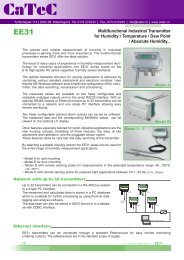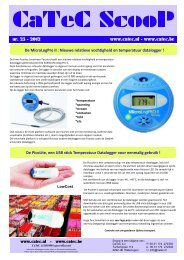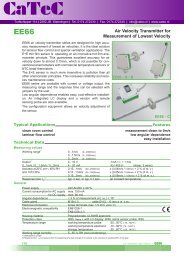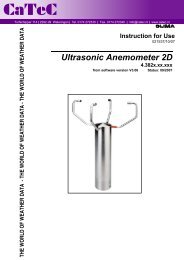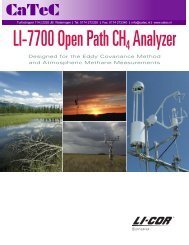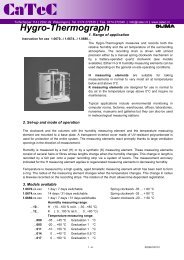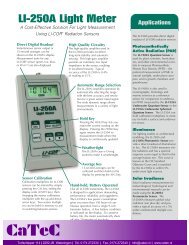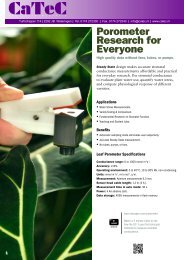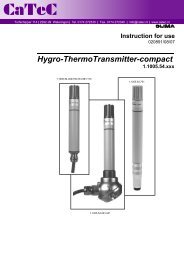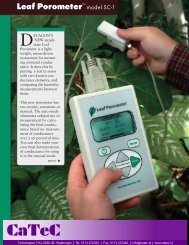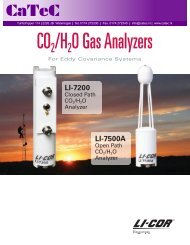li-190sa quantum sensor li-190sa quantum sensor
li-190sa quantum sensor li-190sa quantum sensor
li-190sa quantum sensor li-190sa quantum sensor
You also want an ePaper? Increase the reach of your titles
YUMPU automatically turns print PDFs into web optimized ePapers that Google loves.
Readout Error<br />
This error is due to the readout instrument as distinguished from<br />
the <strong>sensor</strong>. Zero drift, temperature, battery voltage, electronic<br />
stabi<strong>li</strong>ty, <strong>li</strong>ne voltage, humidity and shock are all factors which<br />
can contribute to readout error. The use of electronic circuitry<br />
such as chopper-stabi<strong>li</strong>zed amp<strong>li</strong>fiers and voltage regulators in<br />
LI-COR meters largely e<strong>li</strong>minates many of these problems: zero<br />
drift, temperature, battery voltage, electronic stabi<strong>li</strong>ty, <strong>li</strong>ne<br />
voltage.<br />
Total Error<br />
The errors given are largely independent of each other and are<br />
random in polarity and magnitude. Therefore, they can be<br />
summed in quadrature (the square root of the sum of the<br />
squares). The total error is shown below for an LI-190SA<br />
Quantum Sensor and LI-COR meters when used for measuring<br />
<strong>li</strong>ghting in a typical growth chamber or natural day<strong>li</strong>ght over a<br />
temperature range of 15° to 35°C.<br />
Typical Error<br />
Absolute Error<br />
5% max., 3% typical<br />
Relative (spectral response) Error 5%<br />
Spatial (cosine) Error 2%<br />
Displacement Error 0%<br />
Tilt Error 0%<br />
Linearity Error 0%<br />
Fatigue Error 0%<br />
Sensor Temperature Coefficient Error 1 % (0.1% per °C)<br />
Response Time Error 0%<br />
Long-term Stabi<strong>li</strong>ty Error<br />
2% (2% per year)<br />
Immersion Effect Error 0%<br />
Surface Variation Error 0%<br />
Readout Error 1%<br />
User Error ?<br />
The total error = Square Root (5 × 5 + 5 × 5 + 2 × 2 + 1 × 1) =<br />
7.6%. All of the above errors are minimized by LI-COR through<br />
design and ca<strong>li</strong>bration. While this error seems reasonably low, it<br />
must be remembered that no user error has been added, and that<br />
statistically it is possible that all the errors could be of the same<br />
polarity. The sum of the errors (less the user error) could equal<br />
21% in the worst case. The absolute error is conservatively stated<br />
and is more typically ±3%. User error in vegetation canopies<br />
where shadows and sunflecks exist can be very large (1000%)<br />
and one of the methods described under Spatial User Error<br />
should be employed.<br />
When purchasing a radiation measuring system, it is necessary<br />
to insure that the spatial (cosine, etc.) and relative spectral<br />
response errors are as low as possible. These two errors depend<br />
upon the skill and expertise of the designer and manufacturer.<br />
Some manufacturers de<strong>li</strong>berately do not give specifications for<br />
these errors and the user can expect large errors. The absolute<br />
error is largely dependent on the NBS lamp standard.<br />
Minimization of this error can be achieved by the more experienced<br />
companies through the use of precise techniques and<br />
expensive capital equipment. In order to insure long-term<br />
stabi<strong>li</strong>ty, it is necessary that the manufacturer use the highest<br />
qua<strong>li</strong>ty si<strong>li</strong>con photovoltaic/photodiodes and only the best glass<br />
filters. Modern electronic readout instruments virtually e<strong>li</strong>minate<br />
readout error.<br />
The user should be aware of all the types of errors that can<br />
occur, particularly the relative and spatial errors, since these can<br />
add considerably to the total error. LI-COR has and continues to<br />
put forth a considerable effort to insure that the spectral and<br />
cosine response of all <strong>quantum</strong> and photometric <strong>sensor</strong>s are as<br />
nearly ideal as optically possible. This assures LI-COR<br />
customers of the best possible accuracy.<br />
CONVERSION OF UNITS<br />
Conversion of Photon Units to Radiometric Units<br />
Conversion of <strong>quantum</strong> <strong>sensor</strong> output in µmol s -1 m -2 (400-700<br />
nm) to radiometric units in W m -2 (400-700 nm) is comp<strong>li</strong>cated.<br />
The conversion factor will be different for each <strong>li</strong>ght source, and<br />
the spectral distribution curve of the radiant output of the source<br />
(W λ ; W m -2 nm -1 ) must be known in order to make the conversion.<br />
The accurate measurement of W λ is a difficult task, which<br />
should not be attempted without adequate equipment and ca<strong>li</strong>bration<br />
faci<strong>li</strong>ties. The radiometric quantity desired is the integral<br />
of W λ over the 400-700 nm range, or:<br />
700<br />
W = W d<br />
∫ λ λ<br />
1.<br />
T<br />
At a given wavelength λ, the number of photons per second is:<br />
where h = 6.63 • 10 -34 J•s (Planck's constant), c = 3.00 • 10 8 m s -1<br />
(velocity of <strong>li</strong>ght) and λ is in nm. hc/λ is the energy of one photon.<br />
Then, the total number of photons per second in the 400-<br />
700 nm range is:<br />
700 W<br />
d<br />
∫ hc /<br />
λλ λ<br />
3.<br />
This is the integral which is measured by the <strong>sensor</strong>. If R is the<br />
reading of the <strong>quantum</strong> <strong>sensor</strong> in µmol s -1 m -2 (1 µmol s -1 m -2 ≡<br />
6.022 • 10 17 photons s -1 m -2 ), then:<br />
400<br />
W<br />
photons s<br />
-1 λ<br />
=<br />
hc/ λ<br />
400<br />
700<br />
17 W<br />
6.022 × 10 (R) =<br />
λ<br />
∫ 400 hc/ λ<br />
dλ<br />
Combining Eq. (1) and Eq. (4) gives<br />
700<br />
Wd<br />
17 ∫ λ λ<br />
400<br />
WT<br />
= 6.022 × 10 (RHc)<br />
5.<br />
700<br />
λWd<br />
∫ λ λ<br />
400<br />
To achieve the two integrals, discrete summations are necessary.<br />
Also, since W λ appears in both the numerator and the denominator,<br />
the norma<strong>li</strong>zed curve N λ may be substituted for it. Then:<br />
∑<br />
Nλ<br />
∆λ<br />
i<br />
17 i<br />
WT<br />
= 6.022 × 10 (RHc)<br />
∑λiNλ<br />
∆λ<br />
i<br />
i<br />
2.<br />
4.<br />
6.<br />
27



